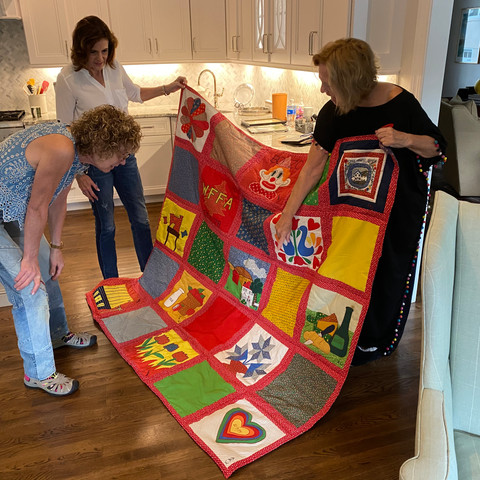Milliken Girls
- Karen Terhune Duncan
- Nov 11, 2020
- 5 min read
In late 1977, just a year out of college, I landed a dream job with a dream company in my dream city, New York. The job combined everything I loved: fashion, travel, event planning, fabrics and sewing. I was part of team who essentially produced traveling fashion shows showcasing the products of Milliken, an American textile manufacturer. Four women, from four corners of the U.S., built the team and a sisterhood. We lived blocks from each other, on the upper East Side of Manhattan, and together we worked long hours and traveled, crisscrossing the country to produce fashion shows for Milliken’s top retail clients.

2020: Three of the Milliken girls together again, in Savannah.
In business since 1865, the corporate headquarters of Milliken was in Spartanburg, South Carolina. We worked in the New York sales building, in the heart of the garment district just across from Bryant Park at 40th street. However, we were on the road most of the year, in every corner of the country. Some small towns, sometimes large cities. We’d spend the summer months in New York planning out the year and then hit the road in September. We became very dear friends. Back in New York as we developed the new show, we’d meet with vendors and production firms to build our sets and design our new lines. Often, we’d have to travel to Milliken’s South Carolina and Georgia plants that actually manufactured our fabrics. Always at the helm was the revered and remarkable Roger Milliken.
In 1854, a 20-year-old entrepreneur named Seth Milliken opened a country store in Minot, Maine. He formed a partnership with William Deering, a dry goods store owner who sold wool uniforms to the Union Army during the Civil War. The two men founded Deering Milliken Co., a wholesaler of fabrics and dry goods. They moved the company to New York in 1868. A year later, William Deering went to Chicago to found Deering Harvester Co. Seth was succeeded by his son, Gerrish Milliken. His son Roger, born in 1915, attended Yale University, where he studied French history. Roger joined the firm at the age of 26 and in 1947, upon the death of his father, became president. By 1958, Roger had ramped up the research organization, built more plants, and had more than 130 patents. That was his passion; innovation. He renamed the firm Milliken & Company and moved the business to Spartanburg, South Carolina, while retaining the New York sales and marketing building.

1980: In Spartanburg with our team. The Milliken Fashion Fabric Representatives are on the far right, me at the very end, next to Louise and Camilla.
I spent many weeks in Spartanburg, and in the actual manufacturing plants; learning how the fabrics, we would be showcasing in our fashion shows, were made. Promotion was at the heart of how Roger Milliken wanted the world to learn about his developments. We did not use traditional advertising firms. We went on the road, store by store, to tell the Milliken story.
During the 1980s, with his company continuing to grow and innovate, Milliken decided to shift the company’s focus again from innovation to quality. And with that move he closed down the Breakfast shows (see photo and caption at the end) and launched an advertising campaign featuring singer Barbara Mandrel and golf legend Raymond Floyd. And my role changed as well wanting to be part of this new direction. It had been all about innovation, innovation, acquisition, acquisition, and then by the ’80s he shifted direction by pioneering a quality movement. By 1984, he helped found the Crafted with Pride in U.S.A. Council, which pioneered an educational campaign to inform American consumers about the importance of domestic manufacturing.
ABOVE LEFT in 1979: The Milliken Girls, a team of four of us who travelled showcasing Milliken fabrics to the consumer. Left to right: Camilla Crist, Adria Willis Biddle, me, Louise Swanson Anderson, and Anna Giosites (our secretary). They had all made me this quilt as a wedding gift, in which they had created dozens of squares illustrating, in fabric, our lives in New York, on the road, and with Milliken. ABOVE RIGHT in 2020: Camilla and Louise examining the quilt they made 41 years ago, that is still a treasure to me.
In Spartanburg I’d host our key customers, who were major clothing manufacturers. One of them lured me to launch their advertising division. So, my 7 years with Milliken came to an end. By 1987 I had started my own agency and eventually, in 1990, my magazine. The foursome of friends scattered, and our contact has been minimal over the decades. Until this year, and Covid. We reconnected, via ZOOM and it’s as if 40+ years melted away. They are each now back in their home states of Minnesota, Missouri and Rhode Island with grown children and grandchildren. Two of them, Louise and Camilla, came to visit us in Savannah in November. It was magic. The years disappeared and we were those Milliken Girls again.

ABOVE: Me, 1981, commentating at one of our many fashion shows, where we'd pack 'em in by the hundreds, usually for two shows a day.
The late Roger Milliken (he died in 2015 at the age of 95) built his company into a multibillion-dollar, international business. At the end of the last century at least nine textile companies, each with annual sales of more than $1 billion, called the United States home. Today, there is only one – Spartanburg-based Milliken. There are more than 7000 associates and operates with 40 manufacturing facilities serving a variety of industries including healthcare, transportation, building and infrastructure, fashion, hospitality, industrial, architectural and specialty chemicals.

Me with Roger Milliken, in Spartanburg, 1983.
With my dear friends, we gathered to reminisce, reconnect, and toast the man who brought us together. As his New York Times obituary aptly stated, “His vision, values, integrity and boundless energy inspire all who follow in his footsteps.” To Roger Milliken, from your Milliken girls.

Every spring, from the 1950s to 1980, Milliken sponsored an annual company musical, the Milliken Breakfast Show, at the Waldorf Astoria hotel grand ballroom, to launch the new season. Broadway veterans included Ginger Rogers, Bert Lahr, Ann Miller, Gregory Hines, Peggy Lee, Phyllis Diller, Gwen Verdon, Sarah Jessica Parker, Chita Rivera, Donald O’Connor and Tommy Tune were just some of the stars who appeared. The cost of these productions could exceed the cost of an actual Broadway show; nearly $1 million for 13 performances, with an audience of approximately 25,000 Milliken buyers. We’d have to be at the Waldorf by 6 am to greet guests. The show began at 8 am and off to the office we all went by 9:30. We worked a full day and often were entertaining clients in the evening. And then back again the next morning. This went on for 2 weeks every April. It was magical in every sense, and both exhilarating and exhausting. Sadly, no recordings of these musicals are known to exist.
The company’s campus is today one of the largest corporate green spaces in the Southeast. Roger Milliken (shown above before his death) was a great lover of trees, a horticulturalist. Doug and I drove to visit it this summer. Now known as the Roger Milliken Center, it is still the company’s corporate headquarters .












Comments